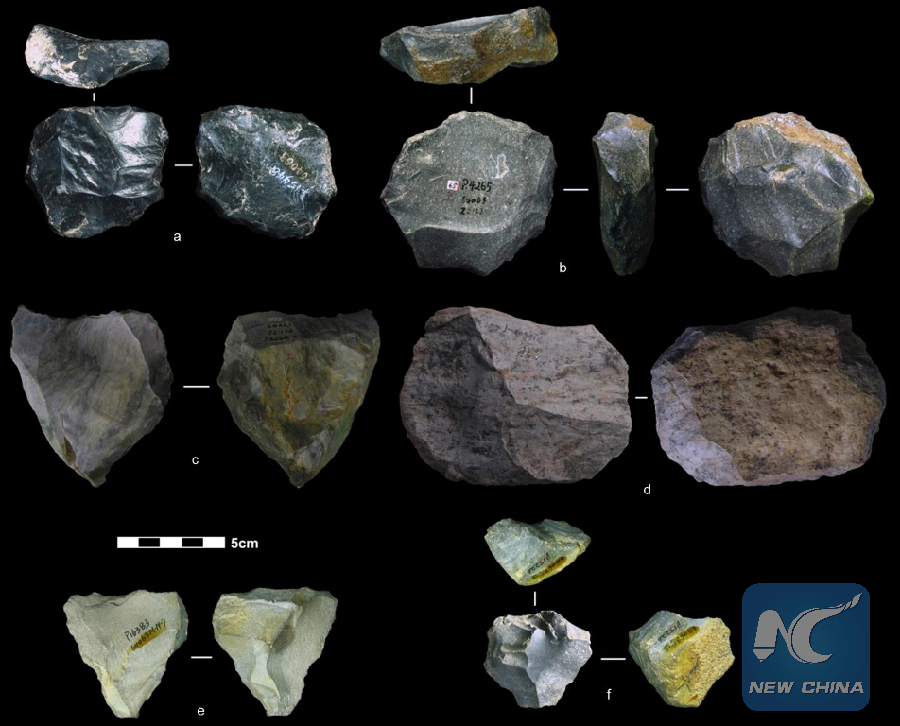
These artifacts found in China are among the nearly four dozen that reflect the Levallois technique of toolmaking. In a paper published Nov. 19 in Nature, researchers date these artifacts to between 80,000 and 170,000 years ago. (Credit: Marwick et al.)
WASHINGTON, Nov. 19 (Xinhua) -- An international team of researchers found that sophisticated tool technology or "Swiss Army Knife of prehistoric times" emerged in East Asia earlier than previously thought.
Analysis of artifacts at a southern China archaeological site showed that carved stone tools were used in Asia 80,000 to 170,000 years ago, according to a study published in Nature on Monday.
Developed in Africa and Western Europe as far back as 300,000 years ago, the tools called "Levallois cores" are a sign of more-advanced tool-making but, until now, were not believed to have emerged in East Asia until 30,000 to 40,000 years ago, according to the researchers.
The researchers believed people in Asia developed the technology independently, offering evidence of similar sets of skills evolving throughout different parts of the ancient world.
"It used to be thought that Levallois cores came to China relatively recently with modern humans," said Ben Marwick, the paper's co-author and associate professor of anthropology at University of Washington.
The tools are named for the Levallois-Perret suburb of Paris, where stone flakes were found in the 1800s.
"Our work reveals the complexity and adaptability of people there that is equivalent to elsewhere in the world. It shows the diversity of the human experience," said Marwick.
The tools are efficient, durable and versatile, featuring a distinctive faceted surface and can be used to spear, slice, scrape or dig. Its knapping process involves a more sophisticated approach to tool manufacturing than the simpler, oval-shaped stones of earlier periods.
The artifacts examined in this study were excavated from Guanyindong Cave in Guizhou Province in the 1960s and 1970s.
NEW ANALYSIS
Researchers once used uranium-series dating and estimated a wide age range of the archaeological site: between 50,000 and 240,000 years old.
Marwick and researchers from China and Australia used a method called optically stimulated luminescence (OSL) to date the artifacts.
The method can establish age by determining when a sediment sample, down to a grain of sand, was last exposed to sunlight, so they managed to determine how long an artifact may have been buried in layers of sediment.
They analyzed more than 2,200 artifacts found at the site, narrowing down the number of Levallois-style stone cores and flakes to 45.
Among those believed to be in the older age range, about 130,000 to 180,000 years old, the team also was able to identify the environment in which the tools were used: an open woodland on a rocky landscape, in "a reduced rainforest area compared to today," according to the study.
LOCAL INVENTIONS IN CHINA
In Africa and Europe, these kinds of stone tools are often found at archaeological sites starting from 300,000 and 200,000 years ago. They are known as Mode III technology, part of an evolutionary sequence that was preceded by hand-axe technology (Mode II) and followed by blade tool technology (Mode IV).
Archaeologists previously thought that Mode IV technologies arrived in China by migration from the West, but these new findings suggested they could have been locally invented.
"Our work shows that ancient people there were just as capable of innovation as anywhere else," Marwick said, adding technological innovations in East Asia can be homegrown, and don't always walk in from the West.
"The appearance of the Levallois strategy represents a big increase in the complexity of technology because there are so many steps that have to work in order to get the final product, compared to previous technologies," said Marwick.
Co-authors of the paper also include researchers from the University of Wollongong in Australia, Peking University in China, the Chinese Academy of Sciences, and the Bureau of Cultural Relics Protection in Guizhou Province.

